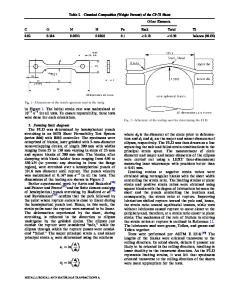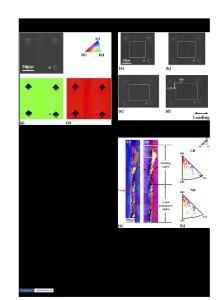Initial stages of recrystallization in aluminum of commercial purity
- PDF / 4,031,133 Bytes
- 10 Pages / 612 x 792 pts (letter) Page_size
- 74 Downloads / 358 Views
BAY AND NIELS H A N S E N
In commercial aluminum with a p u r i t y of 99.4 pct, the formation and growth of recrystallization nuclei were studied by techniques such as i n - s i t u annealing in a high voltage e l e c tron microscope, transmission electron microscopy and light microscopy. Sample para m e t e r s were the initial g r a i n size (370 and 19 microns) and the d e g r e e of deformation (50 and 90 pct reduction in thickness by cold-rolling). It was found that the initial g r a i n boundaries and high a n g l e boundaries within the original g r a i n s a r e preferential s i t e s for recrystallization nuclei, and that the effect of such sites is enhanced by the FeAls particles present in the c o m m e r c i a l aluminum as impurities. The nucleation temperatures determined by high voltage electron microscopy and transmission electron microscopy dec r e a s e markedly when the initial g r a i n size is d e c r e a s e d both a f t e r 50 and 90 pct cold rolling; a less pronounced temperature d e c r e a s e is obtained by increasing the d e g r e e of deformation. The size of the recrystallization nuclei, the recrystallization temperature and the recrystallized g r a i n size are reported for the four sample states, and finally the structural and kinetic observations are discussed.
COMMERCIAL aluminum contains a number of impurities that influence the recrystallization behavior. Of particular importance is iron, which is present in intermetallic particles with s i z e s r a n g i n g from a f r a c tion of one m i c r o n to s e v e r a l microns. P a r t i c l e s in this size r a n g e may strongly affect the recrystallization behavior of the m e t a l because they may act as nucleation sites, such as observed e.g. in F e / F e O ,1 Fe/FesC, 2 F e - S i ,3 and Al-Si-Cu. 4 Preferential nucleation of recrystallization at l a r g e particles may accelerate the nucleation r a t e , and thus r e d u c e the recrystallization temperature or t i m e . Evidence for such an effect has been found in A1-Fe,5 A1-CuA12,6,v CuSiO2, 8'9 Cu-B4C, 1° and Fe-A1203. n In addition t o this effect on the recrystallization temperature (or time), an i n c r e a s e in the number of nucleation s i t e s may dec r e a s e the recrystallized g r a i n size. This situation has been observed in Fe-FeO, ~ F e - S i ,s A1-Fe,5 and A1-Si- Cu.4 Steps in the recrystallization process are the formation of n u c l e i and t h e i r growth. T h e s e processes were studied in the present investigation for a comm e r c i a l aluminum sample with a p u r i t y of 99.4 pct aluminum. Sample parameters v a r i e d t o two levels each were the initial g r a i n size and the d e g r e e of deformation p r i o r to recrystallization, and thus four mat e r i a l states were examined. The structural studies were made u s i n g high voltage electron microscopy (HVEM), transmission electron microscopy in a conventional 100 kV microscope (TEM), and light micros copy.
from impurities in supersaturated solid solution), the starting m a t e r i a l
Data Loading...











